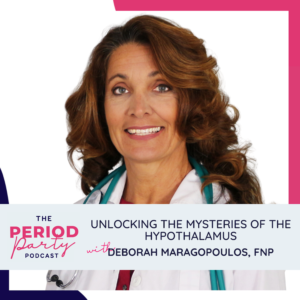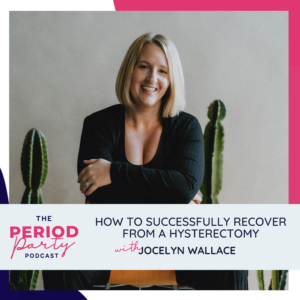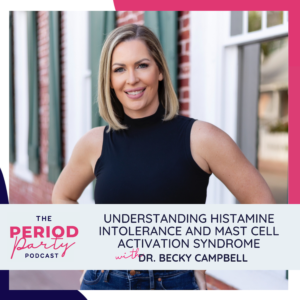Why should you track your cycle? Does it make sense to start tracking while we’re going through such a stressful time? What if your period is missing or irregular? If you’ve been listening to my April solo series, you’ll now have a good idea of what’s normal for your cycle and what to do if you’re experiencing an irregular period. Cycle tracking is the next step in getting acquainted with your menstrual cycle and attaining period literacy.
Quantifying things about your cycle through tracking will empower you to make more educated decisions about your health and wellness. There’s a little bit of a learning curve when you’re getting started but if I can do it, I promise you can too! In this episode, I’m breaking it all down.
The inspiration for this series is my first book, Fix Your Period, which will be out in the world on April 28th and is available now for pre-order (with some incredible bonuses worth over $600!). During this time, I want to give you practical and valuable information that will help move the needle on your health.
In the last episode, I talked about irregular cycles and the fact that they are very common. The problem is we’re often offered the birth control pill or some other form of hormonal birth control as a solution and the underlying cause is usually dismissed. Um, this is not okay! Definitely listen to the last two episodes if you want to know what’s normal and what’s not in the land of periods.
Okay let’s get into cycle tracking and why you want to make this part of your life. This topic is particularly important because we are in the midst of one of the biggest stressors we’ve ever experienced – a worldwide pandemic that has basically shut down economies in multiple countries, caused widespread panic and fear, and resulted in an unprecedented level of stress for a large number of people.
Now that you know all about your period, let’s get to tracking it! Cycle tracking is the first step in getting acquainted with your menstrual cycle and attaining period literacy. Quantifying things such as the length of your menstrual cycle, how many days you bleed, and your period-related symptoms will empower you to make more educated decisions about your health and wellness. While this may seem strange or off-putting at first, I promise you’ll get used to it quickly.
If you don’t already, I recommend that you start tracking your cycle using an app. There are literally dozens of available apps, so I recommend you find one that works for you. Or feel free to track using a paper chart—but let’s face it, tracking your menstrual cycle on your smartphone is much easier and more convenient for most people. Reviewing trends in your cycle-tracking data over months or years is easier when you use an app, and you can share your charts with a partner or your health practitioner via email.
If you have never tracked your cycle, follow the instructions in the “Basic Cycle Tracking” section. If you have tracked your cycle before or are currently tracking the basic symptoms, then check out the “Advanced Cycle Tracking” section to start charting your basal body temperature and cervical fluid patterns so you can determine if and when you are ovulating in your cycle.
PRO TIP: When choosing an app, always check its privacy policy. Yes, some app companies might actually sell your intimate data!
Basic Cycle Tracking
No matter what app you choose, or even if you go old school and keep track of your cycle via paper charts, I suggest you track just the basics first to get into the habit of tracking and avoid overwhelm. Even if this basic tracking is all you do, you’ll still learn a lot about your menstrual health.
As part of basic cycle tracking, when you get your next period you should track:
- the first day and the last day of bleeding – to find out how long your period is
- how heavy or light your flow was on each day
- days of spotting you experience either before or after your period, or at other times in your cycle
the most bothersome physical and emotional symptoms you experience during your period and throughout the entire month. This includes:
- pain that keeps you from doing what you want or need to do
- Intense cravings for sugar or salt
- energy levels (are you completely wiped out on some days?)
- sleep (are there nights you’re not sleeping?)
- bowel movements (suffering from constipation or diarrhea?)
- acne or full-on breakouts
- significant mood swings, brain fog, or anything else that feels distressing to you
I get that it can be overwhelming to even think about tracking all of this at once. So go slow, and start with paying attention to just your period – the first three bullet points. When you purchase my book and get the accompanying workbook, you’ll find all the instructions on how to track your cycle successfully. Work through this cycle tracking section (hint, it’s in chapter 1) as many times as you need to help you fully optimize your menstrual health. Owning your health is a journey. You’ll get the best results when you’re patient and make small changes over time.
Advanced Cycle Tracking
Now, for those of you who are real nerds (like me!) about this cycle- tracking stuff, you can get even more granular about your data collection. The more data that you have, the more you can learn about and improve your cycle.
With more advanced tracking, you’re really tracking three things: cervical fluid, body temperature, and cervical position.39 Considered together, these three things will tell you if and when in your cycle you’re ovulating, which will give you a picture of your unique menstrual cycle patterns and fertility.
This kind of data will be invaluable to you on this journey and in the long term. It puts your cycle in context, meaning that you will know the nuances of your unique menstrual cycle and be able to pinpoint when there are abnormalities long before something serious develops. Imagine being able to compare your current data to data in the coming months once you’ve done the six-week program to see how your menstrual cycle parameters have improved. This is biohacking at its finest!
Record your temperatures and cervical fluid in an app or a paper fertility chart. (See “Workbooks” under “Fertility Awareness Method (FAM) Further Education and Resources” in appendix C).
Step 1: Tracking Your Cervical Fluid
When we know our unique cervical fluid patterns, we are able to determine when we are fertile and when we are not. After your period, you may notice little to no cervical fluid and a “dry” vaginal sensation: when you touch your vulva it feels only slightly moist, and when you wipe yourself it feels dry. As estrogen begins its ascent, your cervical fluid will take on a “wetter” consistency, often becoming creamy (like lotion) or milky, and white in color.
As you enter your fertile window, you may notice it becoming slippery, viscous, stretchy (like egg white), or watery. This is known as fertile-quality cervical fluid. You will also experience a wet or slippery vaginal sensation, meaning that when you touch your vulva, it feels very wet, or the toilet paper will feel slick when you wipe. After ovulation, with the rise of progesterone, the fluid becomes thicker, with a sticky, tacky, or pasty texture, or it may dry up completely.
For the remainder of the luteal phase, you will likely notice little to no cervical fluid and a dry vaginal sensation similar to what you experienced right after your period. You may notice the wetter- quality fluid again around the middle of your luteal phase (about 5 to 7 days before your period). This happens because of a rise in estrogen during that time and is not a sign of ovulation.
I suggest checking for cervical fluid each time you use the toilet to get into the habit. It’s a good idea to wear black or dark-colored underwear so it’s easy to see the cervical fluid when you use the toilet throughout the day. Then make sure to note the consistency and amount of cervical fluid you see each day in your app or on your paper chart.
If you’re not seeing any on your underwear, which is quite common after coming off hormonal birth control, use a finger to check internally. Be patient with your body as she begins to readjust to having ovulatory cycles again.
If you have not been on hormonal birth control and you don’t produce a lot of cervical fluid in the 5 to 7 days before ovulation, don’t worry; it doesn’t necessarily mean there is something wrong. There is a range for cervical fluid production, fluid production declines with age, and everyone is different. If you notice 2 days or less of cervical fluid in your fertile window, and this doesn’t increase after implementing the Fix Your Period program—give it three months— you should work with a trained fertility awareness practitioner and a functional medicine or naturopathic doctor to dig deeper and determine the contributing factors.
The dry-wet-dry cycle is a typical pattern, but there can be deviations from this. If you continue to experience the wet cervical fluid after ovulation occurs, or if you generally notice cervical fluid throughout your cycle, this often indicates endocrine disruption. Keep in mind that your cervical fluid is produced in response to rising estrogen. If you have PCOS or your estrogen is dominant over your progesterone for another reason, such as a thyroid condition, then this could be the cause.
A yeast infection, bacterial vaginosis, or a sexually transmitted infection can also throw your cervical fluid for a loop. If you have a thick white discharge that smells like yeast and is accompanied by itching or irritation, you may have a yeast infection. A fishy-smelling, grayish discharge could be bacterial vaginosis. If you experience any of these symptoms, see your doctor for testing immediately.
How to Tell If You’ve Ovulated by Observing Cervical Fluid
The first step to determine whether you have ovulated is to identify your “peak” day.
Your “peak” day is the last day that you observe fertile-quality cervical fluid or have a wet vaginal sensation in any given cycle.
The name is misleading so it’s important to know that your “peak” day is not necessarily the day of the greatest quantity of cervical fluid or the most wetness
The peak day usually occurs a day or two before you ovulate, but it can also occur on the day of ovulation.
You will be able to determine your peak day only in retrospect: it’s the day before your cervical fluid starts to become sticky or tacky or dry up, and the wet vaginal sensation has dissipated.
Knowing your peak day will help you determine the end of your fertile window: if you observe that your cervical fluid has changed consistency or been dry for 3 days after your peak day, then it’s one sign you’ve ovulated. Make sure to mark your peak day in your app or on your paper chart.
Step 2: Charting Your Basal Body Temperature
A basal body temperature is a person’s temperature first thing upon awakening. Before ovulation, your waking temperature will be on the lower side, often anywhere from 97.0 to 97.7 degrees Fahrenheit (or 36.11 to 36.5 degrees Celsius). A day or two after ovulation, your temperature will typically rise at least two-tenths of a degree and stay elevated until right before your next period. Post-ovulatory temperatures usually rise to 97.8 degrees Fahrenheit (or 36.55 degrees Celsius) or higher. This is caused by the production of the heat-inducing hormone progesterone.
How to Chart Your Basal Body Temperature
To get an accurate reading, you need to take your temperature first thing upon awakening after at least three consecutive hours of sleep and before any other activity such as using the toilet, brushing your teeth, or texting. Your temperature tends to rise about two-tenths of a degree per hour, so aim to take it at roughly the same time every day.
Record your temperature in an app or, if you’re using a paper fertility chart, use a pencil to circle your daily temperature. Each day you can then draw a line connecting your daily temperature to the previous temperature (see “Workbooks” in “Fertility Awareness Method (FAM) Further Education and Resources” in appendix C). You should also note any events such as illness, air travel (especially across time zones), alcohol consumption, or periods of excessive stress, and any temperatures taken earlier or later than usual. You should take all these factors into consideration when interpreting your temperature pattern.
The reason you chart your temperature in conjunction with observing cervical fluid is to determine if and when you have ovulated in any given cycle (see Figure 2 on page 30). Pay attention to when your temperature rises more than two-tenths of a degree above the previous six temperatures and stays elevated for at least 3 days. This is the first step in determining that you’ve ovulated. And once you have combined this temperature shift with the change in your cervical fluid from wet to dry, you can confirm ovulation has occurred.
For many women, it takes three to four months to see a pattern in their temperature readings, so don’t freak out if your basal body temperature appears to be all over the map when you’re just starting out. If you’re ovulating, there should be a pretty distinct difference in the temperatures between the first and second halves of your cycle. If there isn’t, it may be a sign that you are not ovulating (see Figure 3 above), or you may have low progesterone, a thyroid imbalance, or a stealth issue that you should address with a practitioner.
Step 3: Monitoring Your Cervical Position
Your cervical position is the third sign of fertility that you would pay attention to during your cycle. This is not a necessary step, as it merely confirms what your cervical fluid and temperature have to
you, but if you want to feel for your cervix, you damn well should! Your cervix is usually firm and remains low and closed throughout most of your cycle. However, as estrogen increases during the lead-up to ovulation, it causes the cervix to become soft, move up higher in the vaginal canal, open up, and produce the characteristic fertile- quality fluid. The cervix position can be felt by checking internally using your middle (or longest) finger. Please make sure to wash your hands before feeling for your cervix.
Tracking Irregular or Missing Periods
Regular cycles are great, but let’s face it, all women experience times in their life when their cycles are irregular or stop altogether. These times most commonly include when your period begins (puberty), after coming off hormonal birth control, during travel or weight change, postpartum or after a miscarriage, during breastfeeding, and in perimenopause. The great thing about tracking your period is that it can be a tool during all these phases, not just when your cycles are regular.
If your cycles are irregular, keep tracking as normal. Take your temperature at the same time and track your cervical fluid daily. You’ll be able to glean lots of information by tracking, such as if and when you’re ovulating, when your period is coming, and when you’re potentially fertile.
If you are not ovulating but are having a bleed, your charts won’t show a biphasic temperature pattern (the shift from low pre-ovulatory temperatures to high post-ovulatory temperatures) or a clear cervical fluid pattern. Rather, your temperature will bounce up and down (refer back to Figure 3 on page 30), and your cervical fluid will display a basic infertile pattern, rather than going from dry to wet to dry again. When ovulation does return, your chart will alert you to this as well. Seeing a functional medicine or naturopathic doctor is recommended if you have not been ovulating for six months or more (and you’re not pregnant or breastfeeding).
Charting while making these changes will help you identify emerging patterns so you can support your hormones as they move toward balance. Continue charting this way until a period returns.
And you thought it was just a period! Now you are aware, in a way you probably never have been before, of all that is happening in your body each month. This knowledge provides you the opportunity to be engaged with your menstrual cycle in a whole new way.


